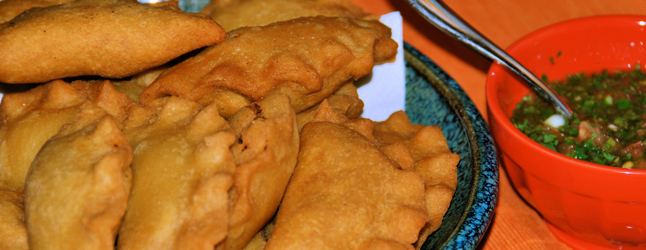

Medellin, Colombia in 1970 was a city of one million people and no drug trade. Or at least not one that dominated anyone’s agenda. The city on most days was filled with two marvelous aromas—coffee and chocolate. The Antioqueñan hillsides surrounding the city were planted with small coffee farms. A regular site was a campesino huddled under his ruana — a Colombian poncho — leading a donkey laden with huge sacks of coffee beans into the coffee cooperative. Some of the beans were roasted there, as were the cocoa beans that also came from the surrounding areas.
We lived on one of those hillsides for two years, and when I think of Colombia it’s not of the later stories of violence and cartels but of coffee and chocolate. It was a lucky time.
I’ve tried several times to replicate the empanadas we often ate with coffee, in the afternoon — served as espresso, and called in Spanish tinto, for “ink.” I’m on a quest for the authentic Colombian recipe for empanadas.
Having proposed to the Carousel of Nations organizers that I would make empanadas colombianas, I wanted them to taste exactly like the ones I remember from my years in Colombia.
Empanadas are the perfect snack — a little meat, a few tiny cubes of potato and tomato, all inside a tiny crispy corn tortilla packet that holds, when you break it apart, a spoonful of aji, salsa but better. In Colombia we ate these by the basketful, at lunchtime, or late in the afternoon with a beer, or very late in the evening, at a bar where the local anise-flavoured firewater, aguardiente, was cheap and the women drank Coca Cola, in a glass with a straw and no ice. I think food is always (for me anyway) associated with the best of the memories of new experiences, and when I think of the things I loved about Colombia, and there were lots, empanadas is one thing that comes to mind right away.
I wanted to make these for international food fair on Saturday, February 4 at the Community Centre. Problem: the masa harina we used to buy ready made at the market is unavailable here. I made one batch with the Bob’s Mill yellow corn masa harina, but the result was thick and doughy. Another batch I made with wheat flour — the way empanadas are made in Argentina and Chile — and baked them in the oven. These were very popular with one of my grandsons. But they weren’t authentically Colombian.
David Rooney came to the rescue producing a 4 litre package of white corn flour or areparina, from Texas. I wasn’t convinced at first, and even David’s family recipe called not for areparina, the white corn flour, but for the white corn itself, to be boiled, ground and strained. No chance. ( I did eventually find areparina in the international food section at SuperStore in Vernon, and I hear there’s a great Latin American food store in Calgary.)
So for two weeks I experimented with the areparina. The first few batches, following the recipe on the package, another few including a video from the Maseca brand (www.mimaseca.com) found on-line, and another in a cookbook, weren’t just right. By adding oil and an egg, we finally got a result that seemed close to the empanada of memory. It presses neatly, holds together, doesn’t split when filled (usually) and has the requisite crispness and offers nice combination of delicacy and toughness.
The Rooney family recipe — also authentically Colombian from their years of living in Cali—for the filling was very like the one I remember, though the women who worked for us (yes, mea culpa the help, without whom I would have been a lost lamb in Medellin and Cali) insisted on three kinds of onion, three kinds of potato, and decreed that these be chopped, not cooked and mashed. I’ve added Maletti Balsamic vinegar as it sparks up the filling and makes a delectable little empanada. But authentic it ain’t.
You can taste my slightly unauthentic empandas on Saturday next, February 4, where Savage Delights will have a table at the Carousel of Nations. And if you want to make your own, here’s the recipe that although not 100% authentic, comes close, and works. Read the whole recipe through thoroughly before you start. This is in three parts: make the filling, make the dough and shape and fill the empanadas, then deep fry them.
Yup: deep fry. This is possibly the only time I will recommend this method of cooking. Use canola oil. Use a candy thermometer that clings to the edge of the pot with a clip. Heat the oil to 350F and keep it there by adjusting the heat underneath. This is most easily done on a gas stove or in a deep fryer. I don’t own one, as I seldom deep fry anything. But heck, most of us eat a French fry now and then, and they’re deep fried. In a culture without ovens — many Colombians cook on one or two burners, nada mas, so deep frying is common. So are pressure cookers and rice cookers, for the two staples of Colombian cuisine, beans and rice. Platano, or plaintain, is sliced finely and deep fried too.
Empanadas colombianas: filling
Make the filling first — days ahead if necessary. Cooked, it can be kept in the fridge for a few days, or frozen until needed. For 50-60 empanadas.
Ingredients
½ lb ground lean beef
½ lb ground pork
2 tbsp olive oil
1 lb mixed white, yellow and red potatoes
1 cup each chopped red and white onion
1 large clove garlic
1-2 cups water.
3 tomatoes
2 tsp ground cumin
1 tbsp sea salt
1 tsp black pepper
2 tbsp Maletti Balsamic vinegar (available at Crescendo shops)
- Steps
In a large skillet, heat the oil and brown and chop the ground beef and the pork. Add the salt and cumin. When the meat is thoroughly cooked, remove it from the pan with a slotted draining spoon, leaving the juices in the pan, and set aside in a large bowl in the fridge. - While the meat is browning, peel the onions and potatoes. Chop both very finely — into cubes 1-2 mm. Do the same with the garlic. This takes a long time. (However, you can — as many colombians do — use a food processor)
- Put the onions, garlic and potatoes into the skillet with the pan juices from the meat, and sauté until the onions are transparent and the potatoes are cooked. Add water little by little as the onion-potato mixture requires it, to keep the vegetables from sticking to the pan or burning.
- Chop or mulch the tomatoes in a food processor and add to the potato mix. Continue to cook over low heat until the potatoes are thoroughly cooked.
- Add the potato-onion-tomato mix to the meat. Add the Balsamic vinegar and taste. Add more salt or pepper if needed. If everyone in your crowd likes hot spicy food, you can add hot sauce or red pepper flakes to taste. Be careful though — the heat in the empanada dish comes from the aji salsa, and traditionally the filling is mild and smooth tasting to contrast with the aji.
Empanada dough
Makes 50-60 empanadas
Equipment
1 large bowl
1 measuring cup, at least 2 cup size
2 flat surfaces, a tortilla press, or 2 perfectly flat plate bottoms
cookie tray or flat surface
Ingredients
4 cups areparina (Maseca brand white corn flour)
3 ¾ cups hot water
8 tbsp olive oil
2 eggs
3 tsp salt
2 tbsp brown sugar
1 tsp ancho chili powder
Steps
- Put the flour, salt and chili powder into a bowl and stir with a whisk to blend.
- Measure the hot water, and add the olive oil and the egg to the measuring cup. Fill to make 2 cups liquid if there’s less than that after adding the oil and egg. Stir to beat the egg and oil into the water.
- Stir to blend, then mix and knead with your hands until the masa is smooth, warm and soft. If the dough is sticky, add 1-2 tbsp more flour. and knead until the dough is smooth and less sticky. If the dough is hard, it won’t press into shape neatly, so don’t add too much flour.
- When the dough is well integrated and smooth, shape into a ball and leave under a damp towel throughout the shape and fill process.
Shape and fill the empanadas
In Colombia women do this shaping between their hands, with a bit of waxed paper or plastic wrap on each side of the dough.
Equipment
• squares of plastic wrap
• a tortilla press OR any very flat surface and another flat board to press down on
- Working with fresh warm masa dough (believe me , you cannot make this ahead and freeze it — I tried), break off a piece of dough in your fingers and make a ping pong ball sized sphere, then flatten it slightly.
- Put a square of plastic wrap on the flat surface of the tortilla press or other flat place.
- Place the ping pong ball of dough in the centre, cover with another square of plastic and press down.
- Press the dough into a neat circle about 4” in diameter.
- Peel off the top paper, flip the dough circle into your left hand, (reverse if you are left-handed) and remove the other piece of plastic wrap.
- Put 2-3 tsp (1 tbsp if possible) of filling in the centre of the circle.
- Gently curl the little tortilla around the filling and press the edges together, fluting them slightly as you work to seal the edges.
- If the tortilla breaks, you probably have made it too thin or too dry. It may take a few tries to get is just right. If the tortilla breaks, put the dough back into the bowl and add warm water, 1 tbsp at a time.
- Once the empanada is formed, place it on a sheet of waxed paper or a flat surface.
Fry the empanadas
- Heat 1 litre of canola oil to 350° F.
- Put 4-6 empanadas in the oil for 7-10 minutes each, turning once after 3 minutes.
- Remove with a slotted spoon and drain on paper towels. Serve immediately with aji picante, below.
Aji picante for empanadas
Makes 2 cups: this goes fast, make lots
Ingredients
8 large scallions
2 large or4 small tomatoes
2 jalapeño pepper
big handful of cilantro
juice of 2 limes
4 tsp vinegar
4 tbsp water
salt and fresh pepper to taste (about 1 tsp each)
hot sauce by drop to taste
Chop the scallions, tomatoes, and the green part of the pepper plus ½ the white inside and seeds. (This is where the heat of the pepper is, so use the whole thing if you like it really hot.)
Add the lime juice, water, salt and pepper and hot sauce.
To eat the empanadas, break one in half and use a small spoon or popsicle stick to put the aji into the shell with the filling. Two bites is about it, maybe three. But oh boy — what lovely bites.



